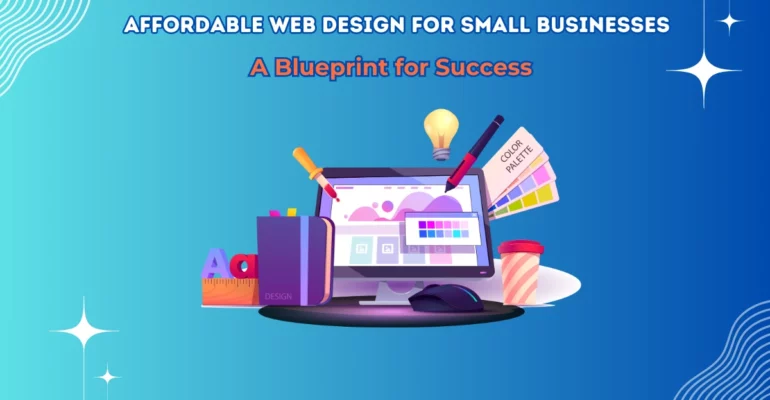Affordable Web Design for Small Businesses: A Blueprint for Success

Affordable Web Design for Small Businesses: A Blueprint for Success
In today’s digital-first world, having a well-designed website isn’t just an option—it’s a necessity, especially for small businesses looking to make their mark. But here’s the catch: you don’t need to break the bank to create a stunning website that works for your brand. At Upinfifty, we know how crucial it is for small businesses to stay on top of their game while keeping costs manageable. That’s why we’ve come up with a guide to creating affordable web designs without sacrificing quality or user experience. Let’s dive into these 12 simple steps that will take your website from “meh” to “wow!”
Smart, Budget-Friendly Web Design for Small Businesses
1. Know Your Business and Target Audience
Before diving into design, ask yourself: Who am I designing for? Understanding your target audience is key. Are you selling products or offering services? Are your customers primarily local, or do you plan to reach a broader audience? Knowing your goals will help define your website’s design elements: colors, layout, content, and functionality.
2. Set a Realistic Budget
Let’s talk about money. You’re running a small business, and while you want a website that looks great, you probably don’t have a giant budget to work with. Start by setting a clear budget. At Upinfifty, we believe in being transparent about pricing and working with you to create an affordable solution that gets the job done right.
3. Choose the Right Web Platform
There are plenty of platforms out there: WordPress, Squarespace, Wix, and Shopify, to name a few. When choosing one, consider your business needs and long-term goals. For example, Shopify is great for e-commerce, while WordPress is a solid option for businesses looking for flexibility.
Tip: Do your research on the platform’s scalability to ensure it grows with your business.
4. Focus on User Experience (UX)
A sleek design doesn’t mean much if users can’t navigate your site easily. Focus on user experience (UX): simple navigation, clear calls-to-action, and mobile optimization. A clean, easy-to-navigate website encourages visitors to stay longer and convert into customers. Our team at Upinfifty prioritizes UX to ensure that visitors can find what they need without frustration.
5. Responsive Design is a Must
In 2024, responsive design is not a luxury; it’s a necessity. With more than half of web traffic coming from mobile devices, your website needs to adapt seamlessly across all screen sizes. Ensure your design is mobile-friendly to keep visitors engaged, no matter what device they’re using.
6. Prioritize Essential Features
Not all small businesses need complex features. Start with the basics: a contact form, an about page, product or service descriptions, and social media links. If your business is in e-commerce, consider including payment gateways and shopping carts. Focus on delivering what matters most to your customers and avoid cluttering the site with unnecessary features.
7. Leverage Templates
Custom web design can be expensive, but using pre-designed templates can give you a polished, professional look without the hefty price tag. Many platforms offer customizable templates specifically for small businesses. We often recommend starting with a template and tailoring it to fit your brand’s vibe saving both time and money!
8. High-Quality Images Matter
Whether you’re showcasing your products, services, or team, high-quality images can elevate the user experience. Avoid stock photos that feel generic; instead, use original images of your business. If you don’t have a budget for a professional photographer, invest in good lighting and take some high-quality photos yourself. Trust us, it’ll make all the difference.
9. SEO-Friendly Design
What’s the point of a beautiful website if no one can find it? That’s where SEO (Search Engine Optimization) comes into play. Design your website with SEO best practices in mind: optimized images, fast load times, clean code, and the use of relevant keywords. At Upinfifty, we can help ensure your site is optimized for search engines, so you don’t miss out on potential customers.
10. Add Social Proof
One powerful way to build trust is by showcasing social proof. This includes testimonials, reviews, case studies, and trust badges. Adding these elements to your website not only provides credibility but also reassures visitors that your business is reliable and trustworthy.
11. Test Your Site Before Launch
Before going live, don’t just assume everything will work perfectly. Test your website thoroughly across different devices and browsers. Check for broken links, slow loading times, and any bugs that might disrupt the user experience. At Upinfifty, we take testing seriously to ensure a smooth launch.
12. Keep Updating and Improving
A website isn’t a one-and-done project; it’s an ongoing effort. Regularly update your content, keep up with design trends, and ensure that everything is functioning well. Small changes here and there can make a big difference in keeping your website fresh and relevant. With our help, you can make sure your website stays current and effective.
Building an affordable, functional website for your small business is completely achievable when you follow the right steps. It’s all about finding the right balance between design, functionality, and cost. At Upinfifty, as a leading Web Design Agency, we specialize in helping small businesses create affordable websites that not only look great but also perform well in the competitive digital landscape. If you’re ready to get started or want some expert advice, don’t hesitate to reach out!





